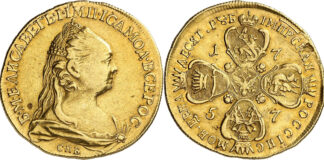
“Thoughts on the amendment to the Municipality Act” was the headline emblazoned across the front page of the twice-weekly Liechtensteiner Volksblatt on 3 May 1924. But the real news of the day was hidden on page 2. “The law regarding the adoption of the franc as currency” stated: “The only lawful currency is the Swiss franc as a Liechtenstein franc. The coins, banknotes and other means of payment that are recognized as legal tender in Switzerland are considered legal means of payment.” The draft law stipulated that, in the Principality, payment could no longer be made with the Austrian krone, but only with the Swiss franc: “Wherever the word “krone” appears in Liechtenstein’s laws, regulations and decrees, it shall be replaced by the word “franc” and the word “heller” shall be replaced by the word “rappen” and the amount shall be left unchanged, so that they are thereafter denominated in the same amount in francs as they used to be in kroner.”

The “editorial board”, as the editorial staff called themselves, was sceptical and couldn’t resist slipping in the question “What does that mean?” And no wonder: the Austrian currency used in the tiny country could no longer be relied upon, a situation that had been getting steadily worse for years. As in Germany, World War I had resulted in hyperinflation in Austria. Prices had doubled every year since 1914. In autumn 1921 the country was hit by galloping inflation, reaching more than 50% per month, and from August 1922 onwards it was more than 100% per month. By now, in nominal terms the cost of living in Austria was 14,000 times higher than before the war. Because money lost its value in next to no time, earnings and savings were spent or exchanged for foreign currency as quickly as possible. Whenever possible, transactions were paid for in kind; if you planned to pay in cash, you needed a laundry basket to carry all the banknotes.

Liechtenstein’s economy, which had always been closely linked to the Danube Monarchy through an economic and currency agreement, was in dire straits. Even though it was neutral, the Principality was also hit hard by the economic sanctions against Austria. The hyperinflation was gobbling up people’s savings, pay and pensions, businesses were closing, petroleum and coal deliveries were irregular, and people were going hungry. Liechtenstein was on the brink of becoming the poorhouse of Europe. And so the country began gradually to dissociate itself from its neighbor to the east. In 1919, Liechtenstein terminated its customs treaty with Austria. Vienna’s immediate reaction was to classify the Principality as a foreign customs territory, and Austria henceforth required an import permit for imports from Liechtenstein.

Printing of Emergency Money
But for Vaduz, the biggest stumbling block was the “foreign currency question”. Before the war, the Austrian krone was still worth roughly the same as the Swiss franc; by the time the war ended, the exchange rate had fallen by a third, only to then go into freefall. In everyday life in Liechtenstein, small change for day-to-day living became scarce. Finally, at the beginning of 1920, Prince Johann II issued a decree providing for the issuance of emergency money. This emergency money took the form of vouchers for 10, 20 and 50 heller, which were valid only on the national territory of Liechtenstein. A decision was made not to issue 1-krone notes, the sole reason being that the Principality couldn’t afford the more complex printing.
But even the new emergency money was of no use: people used the Hellerscheine only in cases of dire emergency, because the emergency heller – like its prototype in Liechtenstein’s neighbour to the east – continued to depreciate rapidly. Meanwhile, the stable Swiss franc gradually became the unofficial currency. People were tired of the massive deprivations of the post-war period, and a veritable black economy based on the Swiss franc gradually arose. As far as possible, only hard Swiss francs were now accepted in payment for goods and services. “No one wants to accept kroner as payment anymore; everyone wants francs”, the Volksblatt stated laconically in March 1920.

Meanwhile, one anecdote had the members of the Swiss National Council chuckling: one morning a blacksmith in Balzers, Liechtenstein, told his customers firmly that from now on he would only work for payment in Swiss francs. His customers, farmers from the surrounding area, were outraged, but the blacksmith sat under his pear tree with his arms folded and waited. Because blunt tools are hard to work with, the following day one farmer after another acquiesced to his demand – albeit only on condition that the smith, for his part, paid for his potatoes in Swiss currency.

In 1923 the government in Vaduz, which had long favoured issuing its own – Liechtenstein – franc notes, finally capitulated: the people had spoken, and they had already made the Swiss franc the common currency. Under the leadership of the Christlich-Soziale Volkspartei, (Christian-Social People’s Party), winner of the 1922 national election, Vaduz now resolutely aligned itself with Bern. The Principality signed a customs treaty with Switzerland, and a raft of Swiss legal provisions were adopted. The country’s property law was based on the Swiss model, and after Switzerland gave its “unconditional agreement”, as the Liechtenstein chargé d’affaires in Bern, Emil Beck, reported to Vaduz, the stage was now set for the Swiss franc to become Liechtenstein’s official means of payment. The Währungsgesetz (currency act), passed by the Landtag on 11 April 1924 and published in the Volksblatt three weeks later, was actually only a draft. But the referendum deadline was not utilised, and so the adoption of the Swiss franc in the Principality of Liechtenstein officially came into force on 26 May 1924.
The article was first published on the website of the Swiss Nationalmuseum.
Here you can read further articles by Thomas Weibel.
Here you can find more information about the Swiss gold coin, which accompanied the currency exchange in Lichtenstein.




